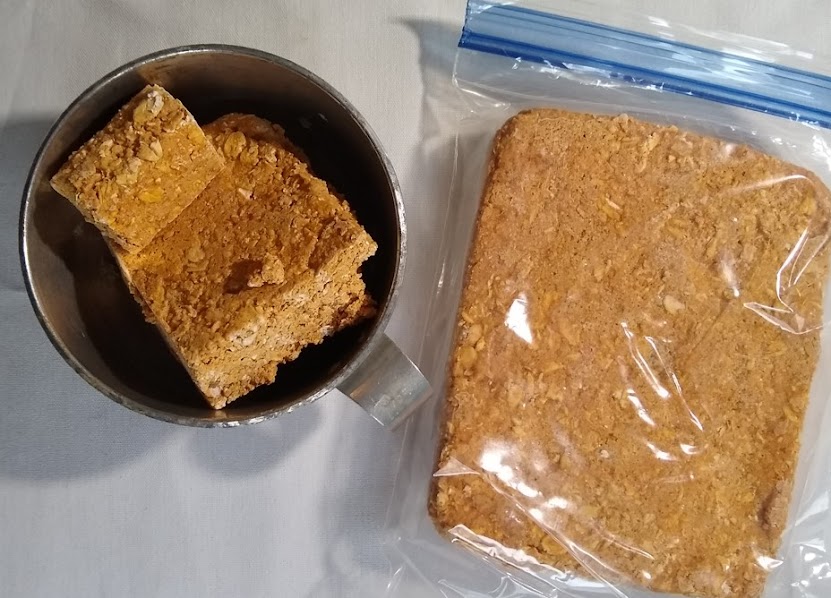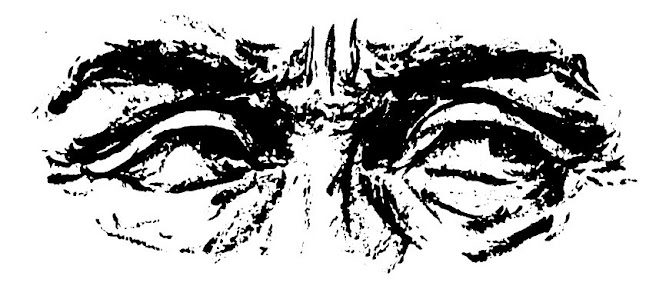Recently,
I was watching some YouTube videos, when a video on making “Survival Bread,
1972”, by Dylan Hollis, HERE,
popped up. It was a good video, Dylan is
very funny, but unsurprisingly, since his show is a comedy cooking show, there
was no new research and no way to fact check his recipe. However, he did mention that his source
claimed that the “Survival bread” would keep for seven years or more.
Four years ago, I had written an article about a “Survival
Rations Bar, 1962”, which was created by Mr. Lee Kelly, a survival
expert, and which sounded very much like the “Survival Bread, 1972” that
Dylan had prepared on his show. I
compared his recipe to the one that I had written about, and found that it was almost
the same, but I couldn’t find anything specifically about a “survival bread”
and “1972”, when I researched it.
So,
I decided to pull-out my survival bars, which had been sitting in storage, and
write a follow-up on my earlier article, complete with some new information and
a “three years in storage” taste test, to see how my “Survival Rations Bar, 1962” has fared over the
years!
But first the
taste test!
The
two the “Survival Rations Bar, 1962”, had
been stored in Ziploc® style freezer bags, and kept in a closed plastic tote,
in my basement, out of the sun, at a humidity of about 50% and a temperature
which averages about 60oF (15°C).
They looked okay, they smelled okay, they were still rock hard, so I
decided to put them to the test of time and taste.
Four years ago, when they were fresh from the oven, I had the bars taste tested by
four very through and competent judges, my children, and my youngest son’s 14 year-old
friend. Then, my 14 year old thought
that they were “great”! While my 19 year old daughter said that they
tasted “okay” and that “they were better than hardtack”, which I
think means that they are good. My 23
year old son said, “these are very good …
they have a good texture … they taste kind of like apples” and my youngest
son’s friend thought that they were “okay”. That makes two polite votes of indifference
and two positive votes. As a tie-breaker,
personally I liked them, I thought that they had a flavor like orange blossom
honey!
Four
years later, I again put them to the taste tested them with four hardy
volunteers. My almost five year old
granddaughter tried some and said, “it’s good, can I have some more”. My youngest son, who is now almost 18 said, “I
liked it, it was good, I’m going in for seconds”. My almost 24 year old daughter stated, “I
wouldn’t eat it for pleasure, but it’s good.
I would take it camping, it tastes like a honey granola bar”. And lastly,
my 26 year old son who said simply, “it’s good”. I thought that they still tasted very good
and I liked how the flavor of citrus Jell-O blended with the honey. So, that makes four positive votes and only
one of polite indifference.
So,
the “Survival Rations Bar, 1962”, passed the test of time and taste,
with a score of 75%!
Just who
was Mr. Lee Kelly, survival expert?
 |
Mr. Lee Kelly, instructing the 416th Signal Aviation Company of Fort Huachuca in survival techniques.
Unfortunately,
Mr. Lee Kelly “of Phoenix, one of Arizona’s best desert survival experts”2,
will remain an enigma. All I have been
able to find out about him, is that he was a desert survival expert, who
trained U. S. Army units and who created the recipe for “Survival Rations
Bar, 1962”. Apparently, he had died
by the time the Desert Survival: Information For Anyone Traveling In The
Desert Southwest 1962, was published by the Civil Defense Joint Council.
How many
ounces were in a box of Jell-O, anyways?
 |
A box Jell-O brand gelatin, circa 1960.
So
just how many ounces were in a box of Jell-O in 1962 anyways? And more importantly, why is that important?
The
earliest record for the “Survival
Rations Bar” recipe, that I could find, was the one published by the Civil
Defense Joint Council, in 1962, which called for ½ a package of gelatin. But unfortunately, they didn’t say how many
ounces of gelatin were in a box! After a
bit of research, I found that Jell-O boxes, circa 1960, contained 3 ounce (85
grams) of gelatin powder.
The
reason this is important is because the modern versions of this recipe all call
for a whole box, or 3 ounces (85 grams) of gelatin, but this is twice the
amount that the original recipe called for.
Why was
everyone talking about “survival bars”?
 |
The annual U.S. Civil Defense Conference took place in Los Angeles, CA between October 16 to 20, 19611.
Just
what in the world was going on during the early 1960s, that had everyone in full
on prepper mode? Oh, right, the Cold War!
Between
September 1961 and the end of October 1961, the Soviet Union detonated a series
of 57 atomic bombs over the arctic island archipelago of Novaya Zemlya. To capped off this series of tests, on
October 31st, they detonated the “Tsar Bomba”, which, at 50
megatons was the most powerful nuclear device ever tested.
 |
Fall Out patterns for the spring of 1962.
So
the “Survival Rations Bar, 1962” recipe
makes a tasty bar, which keeps well, provided you keep it dry and cool, and
still manages to taste good four years later.
And you will only need to use ½ a box of gelatin 1.5 ounces (43 grams)
to accurately reproduce the “Survival Rations Bar, 1962”, a staple of
the 1960s Cold War panic, created by that desert survival enigma, Mr. Lee Kelly.
For
more information read, “Survival Rations … 1962 Civil Defense Style©” HERE
and Desert Survival: Information For Anyone Traveling In The Desert Southwest,
1962 ©, HERE.
Don’t forget to come back next week and read “The More Things Change,
The More They Stay the Same ©”, where we will talk about the similarities
between the situations that the spies and scouts the Indian Wars of the Old
Northwest Frontier of North America, during the late 18th and early 19th
centuries faced, and those that the Special Forces trained Long Range Recon
Patrol (LRRP) soldiers of Vietnam faced.
I
hope that you continue to enjoy The Woodsman’s Journal Online and look for me
on YouTube at BandanaMan Productions for other related videos, HERE. Don’t forget to follow me on both The
Woodsman’s Journal Online, HERE,
and subscribe to BandanaMan Productions on YouTube. If you have questions, as always, feel free
to leave a comment on either site. I
announce new articles on Facebook at Eric Reynolds, on Instagram at bandanamanaproductions,
and on VK at Eric Reynolds, so watch for me.
That
is all for now, and as always, until next time, Happy Trails!
Notes
1
From “Sullivan Wins Funds for CD Conference”, by
Bryant Artis, in the Pittsburgh Press, September 27, 1961, page 13
Sources
Artis, Bryant; “Sullivan
Wins Funds for CD Conference”, Pittsburgh Press, September 27, 1961, page 13, https://books.google.com/books?id=nsAbAAAAIBAJ&pg=PA7&dq=los+angeles+civil+defense+convention++1961&article_id=5131,4297621&hl=en&sa=X&ved=2ahUKEwiwo8bHxPL9AhV3GVkFHQULAvkQ6AF6BAgCEAI#v=onepage&q=los%20angeles%20civil%20defense%20convention%20%201961&f=false,
accessed March 23, 2023
BigOven; “Survival Bread”,
Aisle Ahead, Inc.©, https://www.bigoven.com/recipe/survival-bread/1364366,
accessed March 19, 2023
Civil Defense Joint
Council, Desert Survival: Information For Anyone
Traveling In The Desert Southwest 1962, [Maricopa County; Phoenix,
Arizona ,1962] reprinted in http://docs.azgs.az.gov/SpecColl/1988-01/1988-01-0026.pdf,
page 5-20
EPA;
NEIC Safety Manual, EPA-330/9-74-002-B, [National Enforcement
Investigations Center, Denver, Colorado, February 1977], page 120,
https://nepis.epa.gov/Exe/ZyPDF.cgi/9101ZO3J.PDF?Dockey=9101ZO3J.PDF,
accessed October 16, 2018
Hollis, Dylan; “Survival
Bread, 1972”, https://www.youtube.com/watch?v=7eyTwlQG1T4&ab_channel=B.DylanHollis,
accessed March 19, 2023
Hunt, Kristin; “The
Evolution of Jell-O From 1900 to 2015”, March 7, 2015, https://www.thrillist.com/eat/nation/jell-o-packaging-from-1900-to-2015,
accessed March 23, 2023
Keyingredient.com; “Survival
bread - keeps forever”, March 5, 2014, Keyingredient.com©, https://www.keyingredient.com/recipes/988185034/survival-bread-keeps-forever/,
accessed March 19, 2023
“Making survival bars is
like baking cookies”, The Press-Courier, Oxnard,
California; October 25, 1961 page 11, https://books.google.com/books?id=WQBMAAAAIBAJ&pg=PA6&dq=Civil+Defense+recipes&article_id=3661,5900503&hl=en&sa=X&ved=2ahUKEwj57vP4ytT9AhVSFVkFHfKeB68Q6AF6BAgLEAI#v=onepage&q=Civil%20Defense%20recipes&f=false,
accessed March 18, 2023
“Oops, recipe errs on
atom survival bars”, The Press-Courier, Oxnard, California, October 26, 1961,
Oxnard, California; page 3, https://books.google.com/books?id=WgBMAAAAIBAJ&pg=PA2&dq=survival+bar++civil+defense+recipes&article_id=5665,6024764&hl=en&sa=X&ved=2ahUKEwiI_MD_zdT9AhWsEFkFHVd7B2oQ6AF6BAgDEAI#v=onepage&q=survival%20bar%20%20civil%20defense%20recipes&f=false,
accessed March 18, 2023
Susan; “Survival Bread”, June
8, 2010, http://thereliantself.blogspot.com/2010/06/survival-bread.html,
accessed March 19, 2023
Wallace, John, Lt.;
“Let’s Talk About Survival...I”, United States Army Aviation, Volume 7,
Number 8, August 1961, page 1-2, https://books.google.com/books?id=MDXUoIzWDhMC&pg=RA7-PA1&dq=%22lee+kelly%22+survival&hl=en&newbks=1&newbks_redir=0&sa=X&ved=2ahUKEwiUuOC7idf9AhVVEVkFHQkZA3EQ6AF6BAgHEAI#v=onepage&q=%22lee%20kelly%22%20survival&f=false,
accessed March 12, 2023.







































